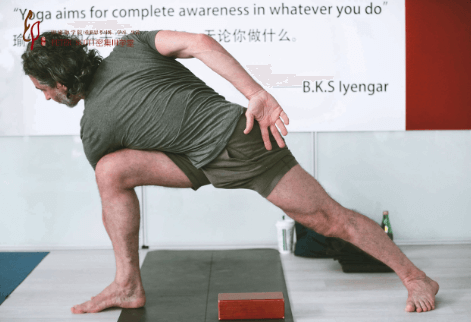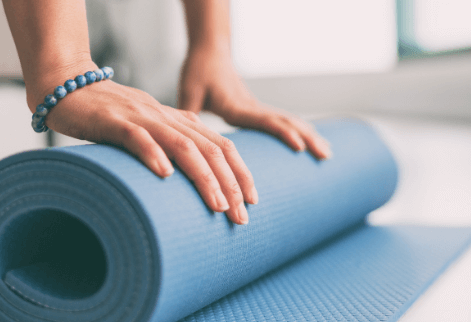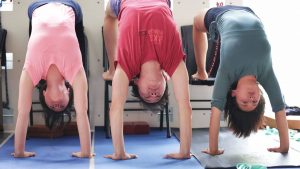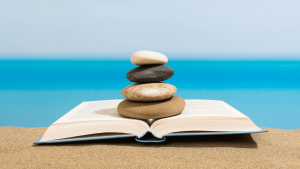Ever looked at the number of yoga classes and the range of yoga styles available out there and felt completely overwhelmed by the amount of information? I wouldn’t be surprised if many of you met this question with a resounding ‘YES!’.
A quick Google search for “Yoga courses Melbourne Australia” produced a whopping 21 pages of information to click on – that’s the result of using just one search engine!
Today, we have access to more information and choice than ever. We google, tweet, whatsapp, email, watch videos, check social media, read online newspapers – all to discuss, form an opinion and find an answer to our question.
Even our options as a consumer have broadened. The average supermarket product range has ballooned from 9,000 in 1976 to 40,000 in 2014 – while we continue to shop within a selection of just 150 products!
It has almost become an art to declutter our minds and our lives.

With this in mind, let’s cut through the yoga information overload. The number of available courses can be confusing, especially when looking to progress your yoga practice, or contemplating yoga mentoring, yoga teacher training and certification.
In the January post, we looked at what contributes to a powerful classroom experience and what lifts a yoga teacher from good to exceptional.
In this article, I’d like to focus on the different yoga training and mentoring styles, which one might be the best for you, and how you may find your direction and firm footing with a holistic style of yoga.
Which yoga style might be the right one for me?
As an experienced teacher, I strive to pass on my knowledge and passion for yoga so that it becomes a valuable part of your life. I see my role as a mentor to every practitioner, regardless of whether they are in a yoga class for the first time, advanced practitioners, or striving to become a yoga teacher themselves.
It’s important to me that you find an approach that allows you to commit, progress, and settle your body and mind.
Iyengar Yoga
With over 40 years of experience, my expertise – and my heart – is firmly rooted in Iyengar Yoga. Created by B. K. S. Iyengar (1918 – 2014), it is recognized as the safest, most scientific and therapeutic style of yoga. It respects each student’s individuality and pace and puts emphasis on the mastery of each pose rather than speed. This, in turn, demands a high level of training of its teachers as well as compassion for each student and the ability to provide individualised guidance.

Pranayama
Alongside Iyengar Yoga, I encourage and guide students to practice Pranayama, breathing techniques and sequences. I value Pranayama as an essential and integral part of yoga to reduce stress, stimulate concentration, and promote overall mental and physical wellness.
But ultimately, when it comes to working out which type of yoga is the best for you, there is really no right or wrong. The choice has to be right for you, at this moment and long term.
Ashtanga Yoga
This is quite an athletic, physical, but also very structured style of yoga. It consists of a set sequence of six specific asanas. Students progress through it once they master each pose and series. That means each student will find their growth point and move through poses at their own pace. Ashtanga Yoga works well for practitioners looking for a more physical, flow-style practice and routine.
Bikaram Yoga
This is basically a hothouse version of Ashtanga Yoga. Instructors do not adjust students. Classes are structured as a set of 26 poses and two breathing exercises. All this is done in a room at 40% humidity and a toasty 40C.
Devotees swear on the detoxifying nature of hot yoga and the added flexibility and improved circulation. This type of hot power yoga is for anyone who likes to sweat, routine and more physical practice.
Hatha Yoga
Deriving from the Sanskrit words for sun and moon, Hatha Yoga is centred around finding a balance between opposing forces such as physical and mental strength, or strength and flexibility. It’s often advertised for beginners as it is generally a gentler form of yoga. But really, it is suitable for anyone who is looking for a balanced practice, including a mix of asana, pranayama and meditation.
Yin Yoga
This style has its roots in both martial arts and yoga. It’s centred around improving flexibility and increasing circulation. This practice targets hips, lower back and thighs and works on your body’s connective tissue in general. You will use props like blankets and blocks in classes.
Yin Yoga can aid with the recovery from a tough workout as it uses deep stretches, holding poses for longer, thus giving body and mind a chance to be absolutely still. It’s for anyone looking for a slower-paced style of yoga or needs a stretch out and recovery after strenuous exercise.
Restorative Yoga
A fantastic self-care practice for people dealing with pain or, in fact, anyone who struggles to relax and de-stress. You might only go through a few poses per class, as each one is held for five or more minutes. This allows you to relax into each pose completely and down-regulate your nervous system. Some classes might also include a guided meditation.

Beginners level to yoga teacher training – which one is right for you?
You might now have an idea of which style of yoga excites you and empowers you. But you might wonder what level is the correct one for you.
If you are completely new to yoga, it is always best to start at a beginner’s level. This is regardless of your fitness, age, or what you want to get out of your practice. In yoga, you will have the same starting point as everyone else. The pace with which you advance, however, is up to you.
Guiding each student through progress and growth is an integral part of yoga teaching and mentoring. I make a point in always being available for a discussion to ensure that your yoga practice has direction and you feel comfortable with it.
Yoga Teaching and Mentoring
With that many styles and levels of yoga offered, there’s an equal amount of yoga teacher training on offer.
Yoga trainer certification
Perhaps the most widely available yoga teacher training courses are the 200HR to 1000HR Advanced Teacher programmes leading to Yoga Alliance certifications. They are for yoga practitioners aiming to deepen their practice or teach yoga.
Iyengar Yoga Teacher Training requires 300 hours of learning with a Level 3 or 4 certified Iyengar Yoga Teacher. Guidelines for these programs can be found here:
Main curriculum components include methods of practice, yogic physiology, practice techniques for age, season and gender, philosophy, ethics, anatomy and physiology, and teaching methodologies. To reach successful accreditation, students must also engage in mentoring and integrative teaching practice (practicum).
Suppose you want an eclectic approach in your yoga teaching, Yoga Australia provides guidance on what memberships and registrations are available and the current curriculum guidelines to achieve yoga teacher certification. To enter the 200HR programme, candidates must have practiced yoga for a minimum of one year.
Iyengar Yoga 250 hours Immersion Program
If you are looking for direction and a firm understanding of the essence of Iyengar Yoga; if you are committed to systematically building your own personal yoga practice, deepen and extend your knowledge through expert guidance and mentoring, rather than aim for straight certification, then this newly developed series is for you.
It offers you:
- unique systematic learning: Daily practice will guide you to build a solid foundation through experience. You will learn how the practice is developed and deepened over time, through sequencing methods. Develop the two essential aspects of the practice stated in Yoga Sutra: Abhyasa (persistence)- that which we are practising and Vairagya (detachment)- that which we are renunciating.
- The benefit of exceptional teaching and mentoring skills: my proven ability to take care of you individually, to inspire and connect.
- Learning advanced Iyengar instructions and concepts, allowing you a broader perspective and deeper understanding of this mind/body practice and immersing yourself completely.
- Learning and practising in a safe and compassionate environment.
If you would like to know more about this new series, please don’t hesitate to contact me directly.
I would like to leave you with this quote. It speaks to my own commitment and passion for this wonderful practice which I hope to share with you:
“Yoga does not just change the way we see things,
it transforms the person who sees”
(BKS Iyengar)
Namaste
Peter Scott



